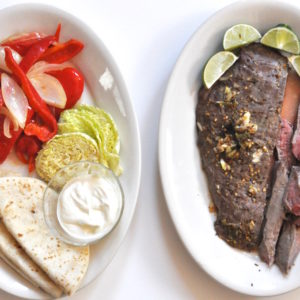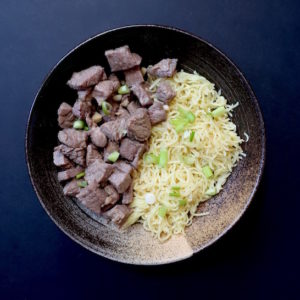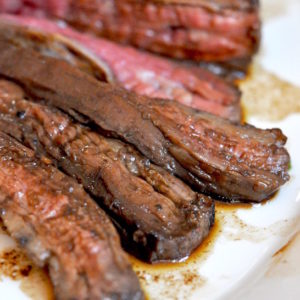Cheap Steak (flap steak in a Port Marinade)
“Cheap” is a relative term, of course. At a time when the cost of living is soaring, and the price of food along with it, steak isn’t featuring in many diets.
While porterhouse and prime rib are off the menu for the forseeable future, flap steak, a cut resembling skirt in taste and texture, is far gentler on the wallet. Two pounds–about 660 grams–cost $12. That’s a fair amount of meat for your money.

Much prettier than raw flap steak.
I used the first pound in a stir-fry. The second pound features here, in a port marinade.
While Port adds a deep, luscious flavor to the meat, it does make a cheap cut more expensive. There is no such thing as cheap port. Nor is there a such thing as inexpensive Madeira, another delicious marination option. Happily, dry marsala is both an effective and inexpensive substitute to either of these wines.

For some reason I didn’t photograph the port.
Avoid sweet marsala and cream sherries, unless you want your steak to taste like dessert.

Undesirable outcome in a marinade. Okay elsewhere.
A scant tablespoon of Worcestshire or Maggi sauce adds piquancy. It also adds salt, so take care not to oversalt before cooking.
As always, garlic is a good thing.

My notes say “2 TBSP red wine. Discuss.” I have no idea what I meant to discuss. To use cheap wine? That I picked up this bottle without noticing its alcohol content, or lack thereof?

Both dark mushroom-flavored soy sauce and Green Mountain Soy Sauce are increasingly easy to find in well-stocked supermarkets. Either works well in this marinade. If all you have is regular soy sauce, that’s fine, too.

Flap steak is a thin cut, and may be cooked under the broiler, in a wok, or in a grill pan. Cooking time is a matter of minutes.

We ate our flap steak in port marinade with tomato salad, sauteéd summer vegetables, and rice.

Leftovers, if you are lucky enough to have any, are good at any temperature, and make excellent sandwiches.

Cheap Steak (Flap steak in a Port Marinade)
prep time: The steak is best marinated overnight, but even an hour is better than nothing.
Cooking time: Less than 5 minutes
Yield: 1 pound/454 grams fed two people.
As always, please see notes, below, for a discussion of ingredient variations and cooking notes.
For the Marinade:
1 piece flap steak, approximately 1 pound/454 grams
2 teaspoons dark soy sauce or mushroom soy sauce
1 scant tablespoon Worcestshire or Maggi seasoning sauce
1 tablespoon Ruby Port
2 tablespoons red wine
1 teaspoon salt
1 teaspoon black pepper
1-3 garlic cloves (according to taste) peeled and lightly crushed
Combine marinade ingredients in a baking dish large enough to comfortably hold the steak. Dip both sides of steak in marinade to coat, then lay steak in dish. Cover dish with foil or plastic wrap. Refrigerate 1-24 hours.
Bring steak to room temperature before cooking.
Steak may be broiled, stir-fried, barbecued, or prepared in a grill pan. If you are oven-broiling or stir-frying, slice steak thinly. Cook in about 6 tablespoons of the same red wine you used in marinade and a little flavorless cooking oil. Sunflower, grapeseed, or peanut oil are best here. The steak will cook within minutes.
Serve flap steak with a port marinade with a salad, potates, flatbreads of your choice, and/or rice. I write at the end of July, when a tomato salad makes a fine accompaniment to the steak. In cooler months, serve flap steak with rice and a cooked vegetable. Spinach, cooked winter squash, or broccoli rabe would all complement the meat.
Leftover flap steak may be refrigerated in a covered container up to four days or frozen up three months.
Notes:
The marinade may be used for other steak cuts, pork, chicken, or tofu. Do not consume uncooked marinade after placing raw meat in it; cook it first. We all have enough going on without getting food poisoning.
The variations to this dish are many. You could marinate the steak in fish sauce and lime, or soy sauce and a quarter cup (60 ml) tamarind. You could lightly salt the meat a few hours before cooking, then give it a quick sear in a blazing hot cast iron pan with some excellent butter, a few drops of cooking oil, and shot of brandy.
Flap steak is delicious in stir-fries and Mexican dishes like tacos, too.
I hate gunky bottle rims, so wipe them off with a rag dampened with white vinegar.

A final note: We say farewell to one of the Doyennes of Mexican Cooking, Diana Kennedy. If you are a non-Latino/a American who takes the tortillas in your freezer for granted, it’s because of her.




